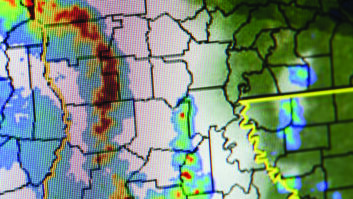A group of leading public broadcast organizations has reiterated their commitment to emergency alert communication in comments filed about EAS improvements proposed by the Federal Communications Commission.
Of paramount importance, they told the FCC, are widespread deployment of FM chips on cell phones, consideration of new mobile EAS communication apps and increased collaboration with emergency management groups.
The group consists of America’s Public Television Stations, National Public Radio, the Corporation of Public Broadcasting and the Public Broadcasting Service.
They detailed arguments for installing and activating FM chips. “If all major carriers and manufacturers activate FM chips in their phones, users will be able to receive emergency alerts, severe weather warnings, evacuation orders or shelter-in-place instructions,” they stated. “Smartphones with activated FM chips capable of receiving free over-the-air emergency broadcasts could serve as lifelines to people facing dangerous situations, especially if the powergrid is down or cellular service becomes overloaded or disabled.”
The pubcasters also detailed emergency alerting efforts of several public TV and radio stations across the country, including Florida stations in a partnership with the Florida Division of Emergency Management. The resultant statewide Florida Public Radio Emergency Network uses public radio outlets to assist the Florida Division of Emergency Management and related agencies to disseminate emergency information through FM radio, as well as through various digital media technologies accessible by cell phone or other battery-powered devices.
The FPREN collectively covers 99 percent of the state. “In the event of a weather incident, the FPREN stations have the ability to provide recovery information for as long as necessary,” the group stated. The public media organizations also noted the success of mobile device applications developed through FPREN, which are able to obtain local and statewide information from any of the FPREN stations at any time and can be delivered via smart phones, tablets or other digital devices.
“The use of state-of-the-art mobile technology allows for the delivery of text messages as well as audio and video content on various media platforms simultaneously, ensuring easy, seamless and widespread consumption by citizens. The content of FPREN programming goes well beyond the capacity of the EAS, with detailed local information delivered around the clock by local news departments.”
They pointed to the FPREN Storm Center, operated by the University of Florida’s WUFT(FM), which has the capability to enable each public radio station to provide detailed local weather forecasts, data and storm updates 24 hours a day. “The format is designed specifically for radio listeners, using descriptive language appropriate to an audience with no access to television, as well as the vision impaired,” a form that would be particularly useful to a mobile audience, the group said.
They argued that the existing public media infrastructure has the unique ability to cost-effectively deliver high-quality video and audio to those who may be in danger, even during disasters or power outages. “As such, public media is committed to improving the usefulness and reliability of EAS and the WEA system.”
They also detailed EAS efforts of television stations, including the creation of a new datacasting system put in place after the Boston Marathon bombing and a multilanguage alerting initiative in place in Minnesota.










